



To characterize the food components of two mussels (wild hard-shelled mussel (HM)
연체동물 부족류 홍합목 홍합과에 속하는 담치무리는 세계적으로 굴과 함께 널리 식용되는 산업적 가치가 있는 중요한 패류로서(NFFC, 2000; NFRDI, 2000; KORDI, 2004), 우리나라 연안에서는 주로 홍합(참담치), 진주담치 및 회색담치 등이 서식하고 있다. 담치무리 중 가장 크고 맛이 좋다고 알려진 홍합 (
실험에 사용한 자연산 홍합은 연중 가장 맛이 있는 시기인2011년 1월에 경남 욕지도 해안에서 채취한 것을 살아있는 상태로 구입하였으며, 이를 탈각 및 족사를 제거한 후 육 부분만을 취해 -20℃ 동결고에 저장해두고 실험에 사용하였다. 한편, 양식산 진주담치는 동일한 시기에 경남 진동만 인근 양식장에서 양식한 것을 살아있는 상태로 구입하였다. 이들 역시 탈각 및 족사를 제거한 후 육 부분만을 취해 -20℃ 동결고에 저장해두고 실험에 사용하였다. 탈각한 홍합과 진주담치 육의 길이 및 무 게는 Table 1과 같다.
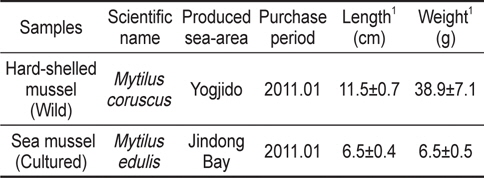
Length and weight of shelled body of hard-shelled mussel Mytilus coruscus and sea mussel Mytilus edulis
일반성분의 조성은 상법(KSFSN, 2000a)에 따라 수분 함량은 상압가열건조법, 조단백질 함량은 semi-micro Kjeldahl 법, 조지방 함량은 Soxhlet 법, 회분 함량은 건식회화법으로 측정하였다. 탄수화물 함량은 100에서 수분, 조단백질, 조지방 및 회분의 함량을 뺀 값으로 나타내었다.
pH는 시료를 균질화한 다음 pH meter (Accumet Basic, Fisher Sci. Co., USA)로 측정하였고, 염도는 염도계(460CP, Istek Co., Korea)로 측정하였다. 휘발성염기질소(volatile basic nitrogen, VBN)는 Conway unit를 사용하는 미량확산법(KSFSN, 2000b)으로, 아미노질소(NH2-N) 함량은 Formol 적정법 (Ohara, 1982a)으로 측정하였다.
총아미노산의 함량은 시료와 6.0 N HCl 용액을 혼합하여 heating block (HF 100, Yamato Co., Japan)으로 24시간 분해 시킨 후 감압건조하고, 0.20 M sodium citrate buffer (pH 2.20)로 정용한 후 아미노산 자동분석기(Biochrom 30, Biochrom. LTD, England)로 측정하였다.
Bligh and Dyer (1959)의 방법에 따라 시료의 총지질을 추출하고, AOCS Official Method (AOCS, 1990)에 따라 검화 및 methylester 화한 후, 지방산을 분리하고 capillary column (Supelcowax-320, Supelco Japan Ltd., Japan)이 장착된 GC (GC-17A, Shimadzu Co., Japan)로 분석하였다. 이 때 GC의 분석조건은 전보(Kim et al., 1994b)와 같고, 각 구성 지방산의 동정은 표준품과의 머무름시간 비교 및 equivalent chain length법에 의해 동정하였다(Ackman, 1989).
시료에 3 배량의 70% ethanol 용액을 가하여 균질기(Ultra Turrax T25, IKA, Janke & Kunkel GmbH & Co., Germany) 로 균질화한 후 17,000×g에서 15분간 원심분리하였다. 이 조작을 2회 더 반복하여 얻은 상층액을 모아 감압농축한 후 증류수로 일정량으로 정용하였고, 여기에 제단백을 위해 5'-sulfosalicylic acid를 10%(w/v) 첨가하여 하룻밤 방치하고 여과한 후 정미성분 분석용 엑스분으로 사용하였다. 유리아미노산 및 관련화합물은 시료 엑스분을 일정량 취해 감압건조한 다음 lithium citrate buffer (pH 2.20, 0.20 M)로 정용한 후 아미노산 자동분석기(Biochrom 30, Biochrom. LTD, England)로 분석하였다. 그리고, 시료 엑스분 맛의 강도에 미치는 각 유리아미노산의 영향은 각각의 유리아미노산 함량을 Kato et al (1989)이 제시한 정미성 유리아미노산의 역치(threshold)로 나누어 얻어진 taste value 로 나타내었다. 트리메틸아민옥사이드(TMAO) 및 트리메틸아민(TMA) 함량은 Hashimoto and Okaichi (1957)의 방법에 따라, 총 크레아티닌(total creatinine)은 Sato and Fukuyama (1958)의 방법에 따라 측정하였다. 베타인(glycinebetaine) 은 Konosu and Kaisai (1961)의 방법에 준하여 Dowex 50w × 20(H+- form) 양이온교환수지를 이용한 column chromatograph 및 ammonium reineckate 염과의 반응을 이용한 비색법으로 정량하였다. 무기성분 중 양이온은 시료 엑스분을 습식회화(Ohara, 1982b)시킨 후 ashless filter paper 로 여과하여 일정량으로 정용한 다음, Inductively coupled plasma atomic emission spectrometer (ICP, Atomscan 25, TJA, USA)로 Na, K, Ca, Mg, Fe 및 P 의 함량을 분석하였고(Yoo et al., 1984), Cl 함량은 Mohr 법(Cho, 2012)으로 분석하였다.
홍합 및 진주담치 육의 가용성 및 불용성 콜라겐 함량은 Sato et al (1986)의 방법에 따라 측정하였고, 조성비는 총 콜라겐 함량에 대한 가용성 및 불용성 콜라겐의 상대비율(%)로 나타내었다.
홍합 및 진주담치를 98℃에서 10분간 삶은 후 최대한 크기가 균일한 것으로 각각 선별한 후 지름 1.5 cm 평판 adapter를 사용하는 레오메터(Rheometer Compac-100, Sun Sci. Co., Japan)로 압착(변형율 70%)하여 얻은 force- deformation 곡선에서 증자 육의 경도(hardness), 깨짐성(brittleness), 탄성(springiness) 및 저작성(gumminess)을 측정하였다(Jang, 1982). 각 parameter 의 계산은 Rheology data system New 9608에 의해 컴퓨터로 처리하였다.
탈각한 홍합 육은 Table 1과 같이 진주담치 육에 비해 평균 체장은 약 1.7배, 평균 체중은 약 6배 정도 큰 것으로 나타났다. 홍합과 진주담치의 일반성분 조성을 분석한 결과를 Table 2에 나타내었다. 홍합과 진주담치의 수분 함량은 각각 75.6과 79.0%로 진주담치가 다소 많았으나, 조단백질과 탄수화물 함량은 각 각 17.0과 15.2%, 3.4와 1.9%로 홍합이 많았다. 패류에 함유된 탄수화물은 대부분이 글리코겐으로 이 글리코겐은 무미(無味) 하나 다른 정미성분과 섞일 경우 맛을 진하게 하고 맛을 상승시키는 역할, 즉 body effect (Park et al., 1994a)가 있는 것이 알려져 있다. 조지방과 회분의 경우는 양자 간에 별 차이를 보이지 않았다.
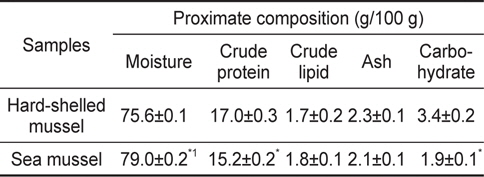
Proximate composition of hard-shelled mussel Mytilus coruscus and sea mussel Mytilus edulis muscle
홍합과 진주담치의 pH, 휘발성염기질소(VBN) 및 아미노질소 함량을 측정한 결과를 Table 3에 나타내었다. 홍합과 진주담치의 pH 는 6.28-6.40이었으며, 어패류 냄새에 가장 큰 영향을 미치는 VBN의 함량은 11.2-12.0 mg/100 g 으로 양자 간에 차이가 없어 냄새의 차이는 거의 없을 것으로 보인다(Oda et al., 1981). 한편, 어패류의 맛에 관여하는 유리아미노산의 총함량과 상관관계가 있는 아미노질소 함량은 각각 250.6 및 227.3 mg/100 g 으로 홍합의 함량이 다소 많았는데, 유리아미노산이 수산물의 가장 중요한 맛성분(Park et al., 1994b; Park et al., 2000)이라는 점을 고려할 때 이러한 유리아미노산의 총함량 차이는 홍합과 진주담치의 맛 특성에 어느 정도 영향을 미칠 것으로 생각되었다.

pH, volatile basic nitrogen (VBN) and amino-N (NH2-N) contents of hard-shelled mussel Mytilus coruscus and sea mussel Mytilus edulis muscle
홍합과 진주담치 육의 총아미노산 함량을 분석한 결과를 Table 4에 나타내었다. 홍합과 진주담치의 아미노산 총함량은 각각 17,451.1과 15,344.8 mg/100 g 으로 홍합이 다소 많았다. 구성 아미노산 중 glutamic acid가 각각 2,205.5와 2,085.0 mg/100 g 으로 가장 많았고, 이외에도 aspartic acid, glycine, alanine, leucine, lysine 및 arginine 등이 많이 함유되어 있었다. 주요 구성 아미노산들의 함량은 양자 간에 약간씩 차이는 있었으나 조성비는 거의 차이가 없었다.
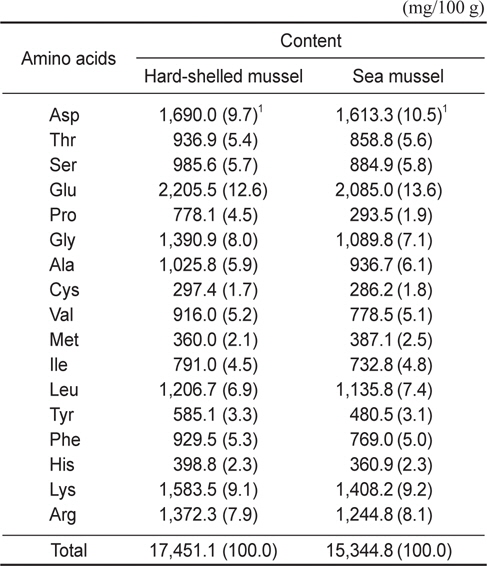
Total amino acid contents of hard-shelled mussel Mytilus coruscus and sea mussel Mytilus edulis muscle
홍합과 진주담치 육에서 추출한 총지질의 지방산 조성을 분석한 결과를 Table 5에 나타내었다. 홍합과 진주담치 총지질의 주요 지방산은 16:0(20.5%, 19.5%), 16:1n-7(8.3%. 8.6%), 20:5n-3(16.6%, 16.5%) 및 22:6n-3(16.7%, 15.9%) 등으로, 홍합의 경우 폴리엔산의 조성비가 50.1%로 진주담치의 46.8%에 비해 약간 높았고, 진주담치는 반대로 포화산과 모노엔산의 조성비가 약간 높았다. 홍합과 진주담치 간에 지방산 조성의 차이는 거의 없었으며, 양자 모두 기능성 지방산인 20:5n-3 과 22:6n-3 을 위주로 하는 고도불포화지방산의 조성비가 매우 높아 국내산 담치류의 근육 지질은 건강기능학적으로 매우 우수하다고 생각된다.
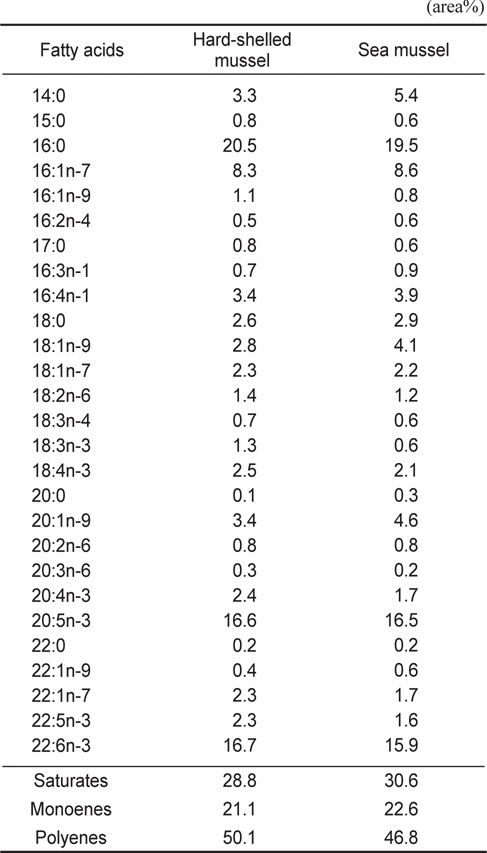
Fatty acid composition in total lipid separated from hardshelled mussel Mytilus coruscus and sea mussel Mytilus edulis muscle
홍합과 진주담치 육에서 추출한 엑스분의 taste-active compounds (Hayashi et al., 1981)인 유리아미노산 함량을 분석한 결과를 Table 6에 나타내었다. 홍합과 진주담치의 유리아미노산 총함량은 각각 1,116.5와 961.8 mg/100 g 으로, 아미노질소 함량과 유사한 경향을 보였으며, 홍합이 진주담치에 비해 약 16%정도 많았다. 주요 유리아미노산으로는 taurine이 각각 177.4와 137.9 mg/100 g으로 전체 유리아미노산의 15.8과 14.3%를 차 지하고 있었으며, 다음으로 glutamic acid, glutamine, glycine, citrulline, lysine 및 arginine의 함량이 많았다. 양자 모두 감칠맛의 glutamic acid, 단맛의 glycine과 alanine, 쓴맛을 지니는 arginine도 비교적 많이 함유되어 있었으며, glutamine과 citrulline의 함량이 많은 것으로 나타났다. Taurine은 맛에는 크게 관여하지 않으나, 삼투압조절 등 물질대사에 관여하는 기능성 함황아미노산으로 홍합이나 진주담치의 조리시에 생기는 구수한 냄새의 형성에 기여할 것으로 생각된다. Glutamine은 생체 내에서 glutamic acid 와 암모니아로부터 합성되며, 암모니아의 대사에 중요한 역할을 한다고 하며, 요소 대사과정의 중간대사 물질인 citrulline은 체내 노폐물을 소변으로 배출시키는 이뇨작용을 촉진시킨다는 것이 알려져 있다. Arginine은 쓴맛을 지니나 적당량 함유되면 진한 맛을 내어 전체적으로 맛을 강화시키는 것으로 밝혀져 있다(Park et al., 1994a). 홍합과 진주담치의 유리아미노산 함량은 다소 차이를 보였으나, 총량에 대한 조성비는 대체로 비슷하였다. 유리아미노산이 수산물의 가장 중요한 맛성분이라는 점을 고려할 때 이러한 유리아미노산 조성은 홍합이나 진주담치 정미특성에 상당한 영향을 미칠 것으로 생각되었다(Park et al., 1994b; Park et al., 2000). 한편, 홍합과 진주담치 엑스분의 유리아미노산 함량을 Kato et al. (1989)이 제시한 맛의 역치로 나눈 taste value는 Table 7과 같다. Total taste value는 홍합이 41.8로 진주담치의 35.3에 비해 높아 맛의 강도가 더 강함을 알 수 있었다. 한편, 본 taste value와 각 아미노산의 정미특성으로 보아 홍합과 진주담치 엑스분 맛의 강도에 미치는 영향은 양자 모두 감칠맛 성분인 glutamic acid가 지배적 이었으며, 다음이 aspartic acid, 그리고 arginine 등이 일부 영향을 미칠 것으로 추정되었다.
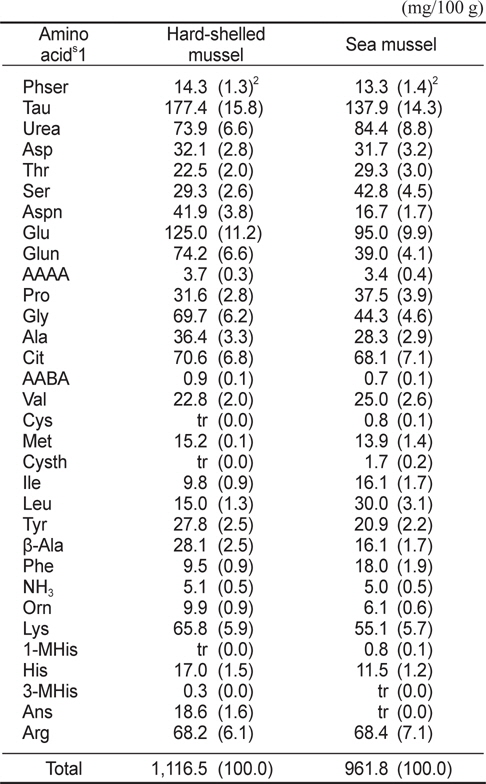
Free amino acid contents of hard-shelled mussel Mytilus coruscus and sea mussel Mytilus edulis extracts
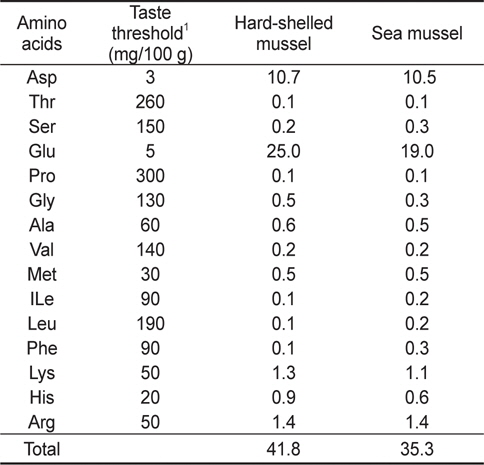
Taste values of free amino acids in hard-shelled mussel Mytilus coruscus and sea mussel Mytilus edulis extracts
홍합과 진주담치 엑스분의 트리메틸아민옥사이드(TMAO), 트리메틸아민(TMA), 총 크레아티닌(total creatinine), 베타인 등 기타 염기성분과 무기질의 함량을 분석한 결과는 Table 8 과 같다. 홍합과 진주담치 엑스분의 TMAO와 TMA의 함량은 각각 96.5과 71.9 mg/100 g, 2.7과 4.4 mg/100 g 으로 TMAO는 홍합이, TMA 는 진주담치의 함량이 약간 많았다. TMAO는 신선한 수산물의 시원한 감미성분으로 선도가 저하됨에 따라 TMA로 환원되어 어패취 및 비린내의 주원인으로 알려져 있다 (Park et al., 1994c). TMA는 미량이지만 역치가 대단히 낮기 때문에 이들이 홍합이나 진주담치의 조리 및 가공시 냄새 생성에 어느 정도 기여할 것으로 보인다(Park et al., 1994d). 한편, 수산물의 떫은맛에 관여하는 guanidino 화합물인 total creatinine 함량은 각각 22.5와 18.8 mg/100 g 으로 홍합과 진주담치 모두 함량이 적으므로 creatinine 은 맛에 일부 보조적인 역할을 할 것으로 생각되었다(Russel and Baldwin, 1975). 연체류나 갑각류에 많이 함유되어 있는 betaine 은 함량이 각각 120.8과 92.3 mg/100 g 으로 정미특성상 시원한 감미를 가지는 물질이므로, 홍합이나 진주담치 국물 맛의 감미 발현에 상당 부분 기여할 것으로 보인다.
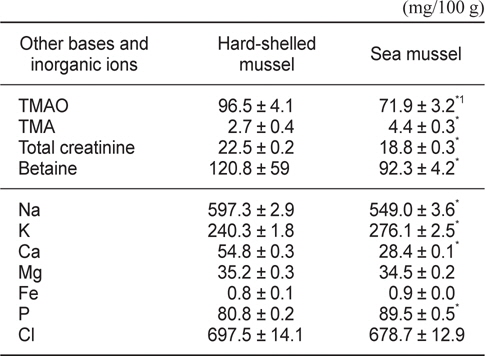
Contents in other bases and minerals of hard-shelled mussel Mytilus coruscus and sea mussel Mytilus edulis extracts
홍합과 진주담치 엑스분의 주요 무기질은 Na와 Cl의 함량이 각각 597.3과 549.0 mg/100 g, 697.5와 678.7 mg/100 g 으로 가장 많았고, 이외에 K, P 등도 비교적 많이 함유되어 있었다. 대체로 양자 간의 무기질 함량 차이는 거의 없었다. Na+, K+, Cl- 및 PO43- 등 무기이온은 자숙 게 육의 주된 정미발현성분이며, 특히 Cl- 의 경우 제거하였을 때 맛의 변화가 가장 컸다는 점과 PO34-를 제거하면 맛의 강도가 약화된다는 점(Hayashi et al., 1981; Park et al., 2000)을 고려할 때 이들 무기이온들은 홍합과 진주담치 맛의 발현이나 조화에 크게 기여할 것으로 보인다.
98℃에서 10분간 자숙한 홍합과 진주담치 육의 물성을 레오메터로 측정한 결과를 Table 9에 나타내었다. 경도는 자숙 홍합이 2,934.0 g/cm2 으로 자숙 진주담치의 967.4 g/cm2 에 비해 2배 이상 단단하였으며, 깨짐성과 저작성도 진주담치에 비해 상당히 높은 값을 나타내었다. 탄성의 경우는 양자 간에 차이가 없었으나, 홍합과 진주담치 간에 조직감의 차이가 있음을 확인하였다. 이들 결과로 미루어 홍합과 진주담치는 콜라겐 등 근육 조직을 구성하고 있는 단백질의 조성이 다소 다를 것으로 추정되었다.
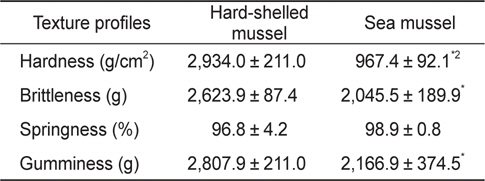
Texture characteristics of the boiled1 hard-shelled mussel Mytilus coruscus and sea mussel Mytilus edulis muscle
홍합과 진주담치의 물성에 관여하는 성분인 가용성 및 불용성 콜라겐 함량은 Table 10과 같다. 가용성 및 불용성 콜라겐 모두 홍합이 265.8과 228.4 mg/100 g 으로 진주담치에 비해 2배 정도 많아 육질에 차이가 있을 것으로 추정되었는데, 이는 Table 9의 결과와 일치하였다. 홍합의 경우 가용성 콜라겐의 조성비가 약간 많은 반면, 진주담치는 가용성 및 불용성 콜라겐의 조성비가 비슷하였다. 콜라겐은 어패류의 가식부 전 부위에 분포하고 근기질을 구성하는 가장 중요한 단백질로서 어패류의 조직감에 큰 영향을 미치는 것으로 알려져 있다(Cho, 2009). Kuboda (1977)는 근육조직 내 섬유 아세포로부터 가용성 콜라겐이 생합성되고, 이러한 가용성 콜라겐은 성숙 과정 중 분자간 가교결합에 의해 불용성 콜라겐으로 변화한다고 하였다. 또한, 수산무 척추동물이나 포유동물의 껍질 콜라겐은 불용성 콜라겐의 비율이 높은 반면, 어류는 가용성 콜라겐의 함량이 높다고 하였다.
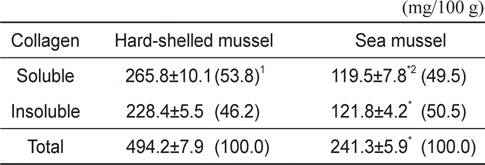
Collagen content of hard-shelled mussel Mytilus coruscus and sea mussel Mytilus edulis muscle









